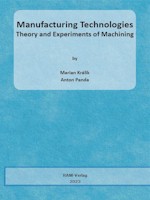|
Vol.11
|
ABSTRACT
The publication analyzes and develops theoretical knowledge about metal machining. Formulated postulates lead in practical conditions to a rational choice of machining conditions with the aim of minimizing the consumption of human labor, the consumption of types of energy and tool material. The intensification and optimization of the machining process requires a set of knowledge about the behavior of the material in the machining process, the phenomena of mutual interaction between the tool and the workpiece, and the changes in the material’s properties during the machining process.
The development of theoretical knowledge about metalworking is largely based on the requirements of development and practice in the production process.
Practice is required to solve machining problems in interaction with other technology problems.
The subsequent understanding of machining also works in the direction that the parts are produced in such a way that it is not necessary to adapt them additionally during assembly.
The publication explains some problems of machining theory. Analyzes are supplemented by conducting experiments, where theoretical knowledge is verified.
KEYWORDS
Technology, Machining, Cuttimg Tool, Tool Life, Machining Theory, Experiments.
INTRODUCTION
Machining (metal cutting) is the process of shaping and sizing materials to a specific form and size. Typically, machining relates to metalworking, although it can also refer to the manufacture of wood, plastic, ceramic, stone, and other materials. If you have raw materials that you wish to mold into a certain shape for a specific purpose, you’ll employ machining procedures to do it. Nuts and bolts, vehicle parts, flanges, drill bits, plaques, and a range of other equipment and things used in a variety of industries are examples of machined products.
Machining can also be seen as a crucial finishing technique in which tasks are created to the appropriate dimensions and surface polish by gradually eliminating surplus material from the prepared blank in the form of chips using a cutting tool(s) that are pushed through the work surface (s). A machine tool is power-driven equipment that removes extra material in the form of chips to size, shape, and process a product to the desired accuracy. Lathe Machines, Drilling Machines, Shaping Machines, Planer Machines, and so on. These are examples of machine tools. Finally, to remove the material of the workpiece’s surface, a cutting tool is employed. To carry out the operation, it must be harder than the workpiece. Cutting tools are divided into two categories; single-point and multi-point.
Most technical components, such as gears, bearings, clutches, tools, screws, and nuts, require dimensions and form correctness as well as a good surface polish to function properly. Performing techniques such as casting and forging, for example, are unable to achieve the required accuracy and polish. Such prepared parts, known as blanks, require semi-finishing and finishing, which is accomplished through machining and grinding. Grinding is essentially the same as machining. Machining to a high degree of accuracy and polish allows a product to meet its functional requirements, increase its performance, and extend its service life.
Some chapters are supplemented with protocols from experiments that can be carried out in laboratories. The template is an aid in processing the results of the experiments.
